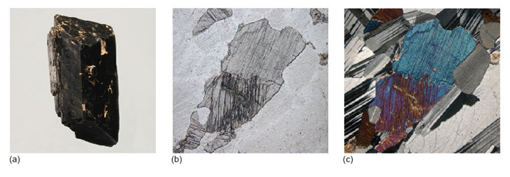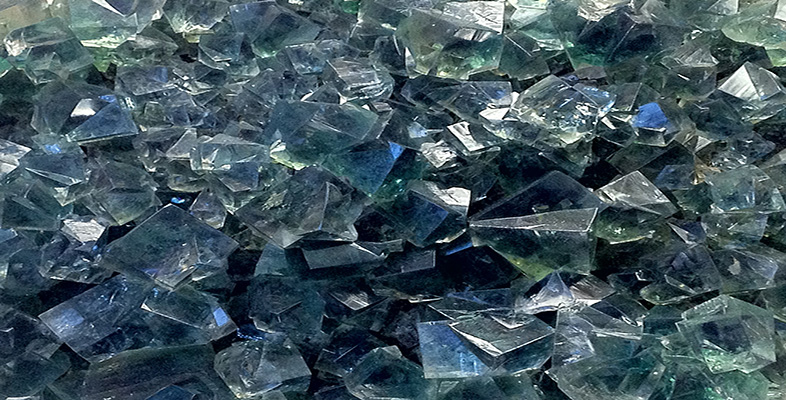3.4 Chain silicates
3.4.1 Pyroxene
The pyroxene group of minerals has the general formula ABSi2O6 (where A and B refer to divalent metal ions in the A and B sites, respectively). Some pyroxenes belong to the monoclinic system; others to the orthorhombic system. Important clinopyroxenes (monoclinic) include augite (Ca(Mg,Fe)Si2O6), and orthopyroxenes (orthorhombic) include enstatite (Mg2Si2O6).
-
Which metal atoms occupy which sites in augite?
-
Using the general formula ABSi2O6, Ca occupies the A site, and the B site contains a mixture of Mg and Fe atoms. Note that the formula of augite implies that there is solid solution from CaMgSi2O6 to CaFeSi2O6.
All pyroxenes are formed of single chains of SiO4 tetrahedra, similar to that depicted in Figure 42. In three dimensions, the chains are interconnected via strong bonds to cations at the B site. The chains that are bonded by the B-site cations are then stacked together to form a strong structure. Adjacent chains mesh into each other and are weakly bonded by a second set of cations, residing in A sites, so for every two SiO3 chain units, there is one A site and one B site.
The differences between the A and B sites are important and are key to understanding the mechanical properties of pyroxene. The pyroxene structure is not uniformly strong and the regions between the chains are relatively weak such that they are likely to break - or cleave - along these directions. This gives two good cleavage directions at approximately 90° (strictly 87° (or 93°)) to each other (Figure 42).
-
When you observe pyroxene cleavages in thin section, will the traces always be at about 90° to each other?
-
The two sets of cleavage traces will only be at about 90° to each other if you are looking down the length of the crystal. This is the basal section for pyroxene. If you were looking perpendicular to this direction (i.e. sideways onto the length of the crystal), there would appear to be only one set of parallel cleavage traces. This is true of the crystal illustrated in Figure 45b. Note, however, that if you were looking obliquely to the basal section the cleavage traces would form a diamond-shaped outline.
In pyroxenes where one set of cleavage traces is visible in thin section (Figure 45b), it is easy to distinguish orthopyroxenes, with straight extinction, from clinopyroxenes, with inclined extinction.

Pyroxenes are important rock-forming minerals commonly found in many igneous and metamorphic rocks. Pyroxenes in basaltic igneous rocks have different compositions from those in andesites. Their occurrence is more restricted in metamorphic rocks but they can be important in those formed at high temperatures.
